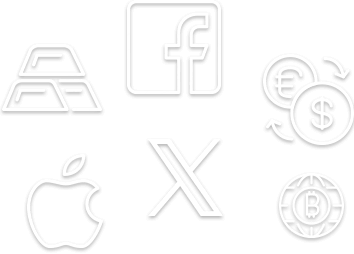Inflation and deflation are two opposite trends in the prices of goods and services. Each of them has its own causes, effects, and solutions. Aside from affecting the prices we pay at the grocery store, inflation and deflation impact workers’ wages and the growth trajectories of major companies, thus leaving a mark on the overall economic picture too. Because of the ubiquity of these concepts in the financial world, it’s crucial for traders of all kinds to get a good handle on them.

Inflation refers to a general rise in the prices of goods and services over time. This implies that:
- The purchasing power of our money is depleted
- Wages will have to rise to make the same purchases affordable for us
- Businesses will have to raise the prices of their products to pay those extra wages
Deflation refers to an overall drop in prices. Although it may sound good, it has several negative consequences including:
- Since prices are down, so are corporate revenues
- This may force companies to lay off workers
- The result of this will be less consumer demand, which perpetuates the deflationary spiral
Some level of inflation (say 2%) is actually desirable for the economy because:
- When people know that prices are steadily rising over time, they won’t delay large purchases
- This keeps corporate revenues consistent, which allows companies to grow and hire more workers
- Since people know that their savings are being steadily eroded, they will be motivated to put them to work (rather than hoarding them), which is healthy for the economy
Even though deflation would be expected to decrease a currency’s value (since it signifies weak demand and economic stagnation), this didn’t always happen to the Japanese yen in the deflationary 1990s and 2000s because: - Global traders viewed it as a safe haven in times of economic crisis like the one in 2008, so the yen increased in value
- Since other currencies were losing value while the yen was not, this boosted the relative strength of the yen
- Carry traders borrow the low-interest-rate yen to buy higher-yielding currencies like the Australian or US dollar. When risk sentiment fades, they unravel their positions, buying the yen to repay loans. This drove periodical yen surges
iFOREX Europe keeps clients on the ball on the score of key economic concepts by:
Offering traders quality educational materials that explain concepts step-by-step and in the correct context and giving them the chance to talk with a human agent whilst setting them up with a live demo account to practice applying concepts in real market conditions.
Conclusion:
- Inflation is the trend of rising prices over time, and it affects both consumers and businesses very strongly, both for the good and the bad
- Deflation is the trend of falling prices over time, and its effects are mostly negative, as was evident in Japan in the 1990s and 2000s
- Open a trading account with iFOREX Europe today to access our array of educational resources, which come in both written and video form.
Frequently asked questions
How do high interest rates fight inflation?
Hikes in interest rates increase the cost of borrowing, which encourages households and businesses to borrow and spend less. Since large purchases are now put off, businesses stop expanding and lower prices what cools this cools inflation, especially in sectors that rely heavily on consumer spending plus, higher US interest rates will attract foreign capital, thus strengthening the US dollar. This will make imports cheaper for Americans and reduce inflation
Why do central banks target 2% inflation?
When consumers know that prices will be rising at this moderate rate over the coming months, they make large purchases sooner rather than later. This sends steady revenue streams into companies, allowing them to expand and employ more workers. From the perspective of businesses, moderate inflation is good because it means their revenues rise
What causes inflation?
Inflation can start with a price shock, for example a large rise in oil prices of commodities , necessary for keeping life globally going.
Workers then demand higher wages to keep up with prices and businesses raise product prices to pay off the increased wages, thus perpetuating the inflationary spiral
What causes deflation?
This can begin with a marked weakening in demand, perhaps due to a collapse of consumer confidence. Businesses then lower product prices to encourage buying and when consumers see lowering prices, they put off purchases leading to company layoffs and even weaker demand, thus perpetuating the deflationary spiral

